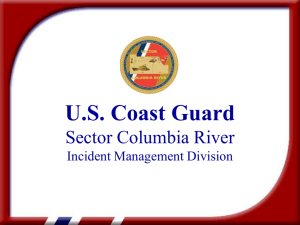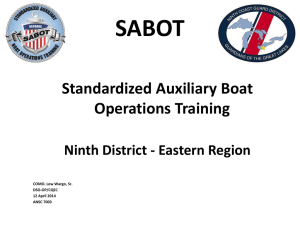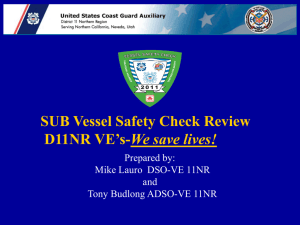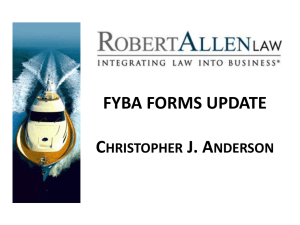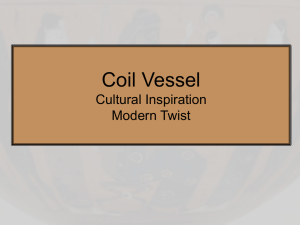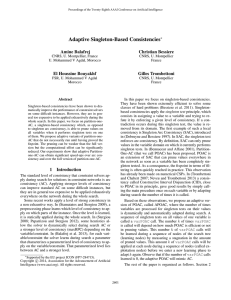POAC - Intertanko
advertisement
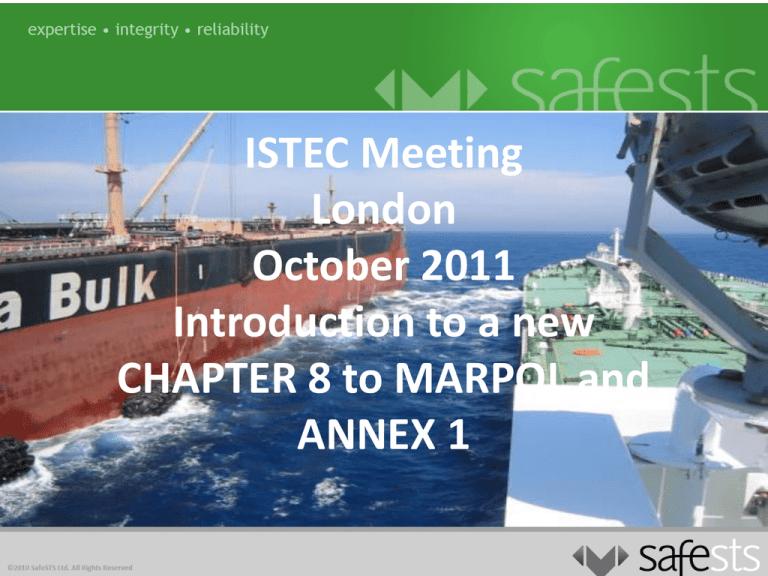
ISTEC Meeting London October 2011 Introduction to a new CHAPTER 8 to MARPOL and ANNEX 1 IMO Chapter 8 - Implementation IMO adopted by Resolution MEPC. 186(59) a new Chapter 8 to Marpol and Annex I, aimed at the prevention of pollution during Ship-to-Ship Transfer of oil cargo. Implementation has started on Jan 2011 with full implementation for Jan 2012 Change in STS regulation by Marpol Implemented through Vessel ISM • • • • Say what you do Do what you say Record it Thereby enforce accountability IMO Regulation Marpol – Chapter 8 Reporting requirement to appropriate authorities Vessel Specific STS Plan Reporting Requirement • 48 hours Notice to Authorities for ops within territorial waters or EEZ. Details of the Report Notification to authorities • Details of the ships • Time and location of transfer • Type of STS operation • Oil type and quantity • Duration of STS • Service Provider and/or name of POAC • Confirmation of vessel having STS Plan Flag Administrations have “teeth” They can (and sometimes do) have additional requirements like; • (Gibraltar) Asking for the STS Plans • (Denmark) Approving (or Disapproving) the POAC • (UK) Requiring a vessel inspection pre operation (i.e.; • Implement the Paris Memorandum) Impose additional pollution response measures; • • • • (UK) Tier 2 response (Panama) Assign pollution officer (Korea) Response boat with operation (Spain) Ultimately stop the operation going ahead Vessel Specific STS Plan IMO Guidance 6.2.4.2 1. 2. 3. 4. 5. 6. 7. 8. Step-by-step description of entire operation Detailed description of mooring operations Detailed description of cargo / ballast procedures Titles/Duties/Locations list for all persons involved Emergency shutdown/communications for emergency breakaway Oil spill plan Contingency plan that meets 6.2.9 Cargo and ballast plan Vessel Specific STS Plan IMO Guidance 6.2.4.2 1. 2. 3. 4. 5. The Vessel plan does not on its own full-fill the requirements of the IMO. The Service provider must provide a significant amount of information required by the Vessel Plan for each area. All this information must be collated on the vessel prior to the operation starting. The POAC is responsible to the Coastal State for completing this task and following the plan. Due diligence by the ship-owner is not just a paperwork exercise. There are potentially severe penalties for non compliance Contingency plan 1. Risk assessment (As per Sect 1 - 6.3 Manual on Oil Pollution) 2. Mitigation measures and plans 1. Covering all possible emergencies 2. Providing comprehensive response 3. Notification to Authorities 3. 4. 5. 6. Emergency duties for designated crew Consideration on standby vessel SOPEP or VRP integration Action in the event of a spill The role of the “POAC” PERSON IN OVERALL ADVISORY CONTROL Regulatory Compliance Technical Guidance Procedural Delivery Safety Supervision POAC Qualifications; • International Standard Certificate of Competency • All STCW and Dangerous Cargo Endorsement up to date and appropriate • GMDSS • Ship Handling Course • Cargo familiarisation course • Oil spill Response training POAC Experience; • Tanker loading/unloading • Thorough knowledge of the transfer area and surrounding areas • Conducted a suitable number of operations in similar circumstances • Regional Oil-Spill Response capability as part of the response plan • Thorough knowledge of the transfer plan POAC Responsibility; • Ensure the plans for both vessel are followed • Advise both masters • Ensure contingency plans followed • Ensure reports to authorities are made • Brief both vessel crews • Ensure communications satisfactory • Ensure safety checks are undertaken Case Study Bunker Storage Vessels; A sea going vessel is acting a floating storage for months or years. A bunker tanker fills up her tanks alongside on a regular basis. Is this operation affected by the new regulations? Case Study Bunker Storage Vessels; • This is wrongly considered as bunkering in some ports. It is Ship-to-Ship. • Vessels are both over 150 GRT therefor both need to comply with Marpol. Potential Issues • Vessel STS Plans are too big to email. • Charter Party clauses do not cover new rules. • Plans not compatible • • • • • Plan WX Criteria not suitable for intended operations Vessel criteria (e.g.. open chocks on daughter vessel) POAC qualifications Working hours Pollution response requirement Points to Ponder • Insurance for POAC. • • Is the Master Insured to take responsibility for advising another vessel as per POAC. (e.g.. If the other vessel has a pollution incident, the POAC/Master is accountable to the Coastal State for compliance to the plan). Acting as the “Pilot” offshore is outside the protection of the Pilotage act. The POAC could potentially be held responsible for damage to the other vessel if the plan is not followed (quote from Norton Rose. Maritime lawyers). Enforcement of STS Regulation • Records of compliance have to be retained onboard for three years. • A non-compliant vessel could be; • • • Improperly filling in Oil Record Book In breach of the ISM Code In breach of Marpol Regulations • If the plans are not followed, the POAC may initially be held accountable for incidents by the Coastal State. What do the changes mean? Greater power for Coastal State Increased ship-owner liability Increased Master/POAC liability Increased responsibility for STS Service Provider / POAC Threat to reputation from substandard operations Additional cost implication Delays from slow notification Delays due to non-compatibility of vessels Loss of trading opportunity from rejected plans Example Guidance for Implementation Ship to Ship Transfer Operation Plan (Design and Audit Checklists) Lloyds Register website www.lr.org ISO Accreditation • SafeSTS is ISO 9001:2008 accredited for STS transfers Contacts If you would like further information please contact us... Tel: +44 (0) 1379 640021 (UK) or Tel +65 9818 6203 (Singapore) Email: operations@safests.com Website: www.safests.com



